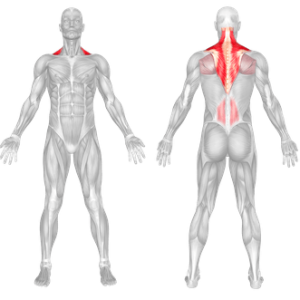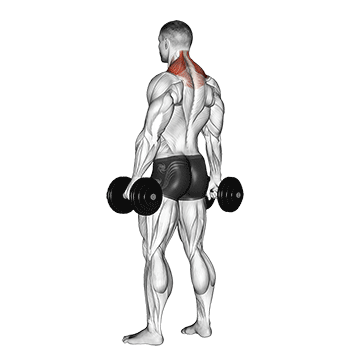Dumbbell Shrug
Dumbbell shrugs are an exercise that primarily targets the trapezius muscles, which are located on the upper back and neck area. Overall, dumbbell shrugs are a simple yet effective exercise that can provide many benefits for your overall fitness. Whether you’re a beginner or an experienced gym-goer, adding dumbbell shrugs to your workout routine can help you achieve your fitness goals.
How to do:
Dumbbell shrugs are a simple exercise that can provide great results if done with proper technique. Here are some tips on how to perfect your dumbbell shrug technique for maximum results:
- Start with a light weight: It’s important to start with a light weight that you can comfortably control with proper form. As you get comfortable with the exercise, you can gradually increase the weight.
- Stand up straight: Stand with your feet shoulder-width apart, and keep your back straight and your shoulders relaxed.
- Hold the dumbbells correctly: Hold a dumbbell in each hand with your palms facing your body. Your arms should be straight down at your sides.
- Raise your shoulders: Slowly lift your shoulders straight up towards your ears as high as possible, keeping your arms straight. Make sure to use your scapula and traps to lift the weight, not your biceps or your neck.
- Hold the top position: Hold the top position for a moment, making sure to contract your traps fully.
- Lower the dumbbells: Slowly lower the dumbbells back down to the starting position, keeping your arms straight.
- Repeat for the desired number of reps: Aim for 3-4 sets of 10-15 reps.
It’s important to use a weight that you can control and maintain proper form throughout the exercise. You can also modify the exercise by using heavier weights, performing the exercise one arm at a time, or performing the exercise on a machine.
Dumbbell Shrug Benefits
Dumbbell shrugs are an effective way to strengthen your trapezius muscles, which are responsible for stabilizing and moving your shoulder blades. Strong traps can also improve your posture and reduce the risk of shoulder injuries.
The trapezius muscles are composed of three parts: the upper traps, middle traps, and lower traps. Dumbbell shrugs primarily target the upper traps, which are responsible for elevating the shoulder blades and stabilizing the neck.
During a dumbbell shrug, you lift the weights by contracting your upper traps, which causes your shoulder blades to move upward. This movement also helps to stabilize the neck and prevent it from moving excessively during the exercise.
When you hold the top position of the shrug for a moment, you activate your traps fully, which can lead to muscle hypertrophy (i.e., muscle growth) over time. This muscle growth can lead to increased strength and improved posture.
However, it’s important to note that the middle and lower traps are also important for overall shoulder stability and posture. To fully target the trapezius muscles, it’s recommended to incorporate a variety of exercises that target all three parts of the muscle.
Here are some variations of dumbbell shrugs that you can incorporate into your workout routine:
Gittleson Shrugs: This variation targets one side of your body at a time, allowing you to focus on each side equally.
Wide-grip Barbell Shrugs: A wide grip can target the outer part of the traps, helping to broaden the upper back.
Behind The Back Barbell Shrugs: This variation involves shrugging your shoulders down and back instead of up, targeting the lower traps and rhomboid muscles.
Alternating Dumbbell Shrugs: This variation involves alternating between lifting one shoulder at a time, helping to improve muscle symmetry.
Overall, varying your dumbbell shrugs is important for optimal muscle growth and to prevent boredom and injury.
Dumbbell Shrug Muscles Worked
Dumbbell shrugs primarily work the trapezius muscles, which are located in the upper back and neck area. Specifically, the exercise targets the upper traps, which are responsible for elevating the shoulder blades and stabilizing the neck. However, other muscles in the shoulder and upper back also assist in the movement, including:


